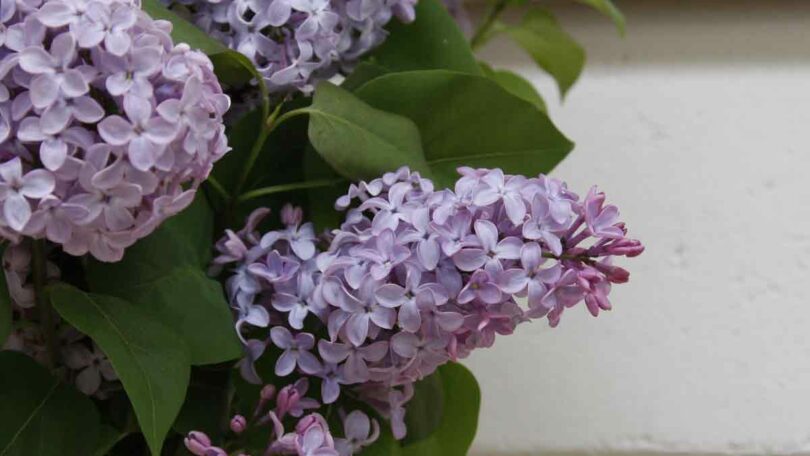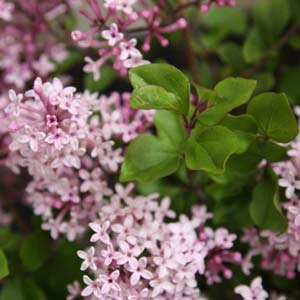Lilac trees (Syringa spp.) have been cherished by gardeners across the country for generations, and it’s easy to see why. These deciduous trees or shrubs are easy to care for and have elegant flowers with a wonderfully strong scent that fills the air with a sweet perfume, especially in warmer climates.

The most well-known or common lilac is the Syringa vulgaris. Its flowering season varies from early spring to summer, depending on the variety and climate zone.
It is Madame Lemoine a cultivar of the common lilac that is well known for its fragrant, double white flowers. The flowers are often tinged with a hint of cream or pale yellow.
How to Grow the Common Lilac
Soil:
All common lilacs, including Madame Lemoine, prefer well-drained soil that is slightly alkaline to neutral. They can tolerate a range of soil types grow best in a humus rich well drained soil. Drainage is important to prevent root problems.
Sun/Light:
For good growth and flowering plants in full sun. A position whichreceives at least 6-8 hours of direct sunlight per day is ideal.
Watering:
Lilacs are reasonably drought tolerant once established, they perform better in a moist soil. Water newly planted lilacs regularly, and ensure that the soil remains consistently moist until the plant establishes itself. Once established, lilacs deep watering during dry periods is recommended.
Fertilizer:
Although lilacs are not heavy feeders, some growers recommend using a light application of general purpose slow release organic type fertiliser in spring.
Over-fertilising can result in lush foliage growth but poor flowering. We prefer a good layer of mulch and a little well-rotted cow manure each year in spring, for us this is adequate.
Pruning Syringa vulgaris
Removing the older stems not only rejuvenates the bush but it also helps prevent insect pests and diseases.
Lilacs flower on two-year-old wood, so to prune them accordingly. Pruning can be done after flowering. For shape maintenance, a light pruning is sufficient.
Older plants can become a little large and woody over time. For best flowering performance, they may need some severe pruning. If they have been neglected, start by removing all dead and damaged wood, then remove one-third of the remaining stems, starting with the oldest. Over 3-4 years, you will have a healthy, rejuvenated plant.
French lilacs (Syringa vulgaris) can handle heavy pruning. Each year, prune away one-third of the oldest stems in winter or very early spring. Leave 8-12 main canes and trim them back about 30cm less than your desired height just after flowering for a second flush of flowers.
The Tree lilacs are pruned back to one main stem. Generally speaking, all varieties are best pruned back to a height that will give flowers at head height. This maximises both the visibility and the perfume.
More information on Syringa vulgaris
These plants can be grown as a bush or shrub or trained as a standard. While the botanical name is Syringa vulgaris, a delightful array of cultivars are available, each offering distinct flower colours and growth rates.
Classic Lilac flowers are typically a pale blue, there are also varieties with deeper purple to mauve, white and red flowers.
Lilac trees reach full bloom in spring. They might not be as showy the rest of the year, but their spring blooms more than make up for it. They are suited to be grown in garden borders and can be used as a seasonal feature plant.
Dwarf cultivars suited to growing in containers are also available for sale from selected nurseries. The growth rate will vary from 30 to 60cm a year, depending on climate, soil and variety.
If you are looking for smaller lilac tree varieties that can thrive in your garden, consider the Korean Lilac S. meyeri “Paliban” or Syringa “Miss Kim”.
Planting Syringa vulgaris Step By Step
- Choose a position with good sun. 6 hours a day is a minimum for good flowering.
- Make sure the soil is well drained. Hill up the soil in wet or heavy clay soils if needed.
- Dig the soil over well, remove weeds and add some well-rotted compost and cow manure.
- Dig the planting hole twice as wide as the container. Always plant at the same level the plant was in the container.
- Plant in late summer. This gives the Lilac time to put on some root growth before winter.
- Water in with a liquid seaweed fertiliser.
- Mulch around the plant to maintain a cool root run.
- Avoid using too much fertiliser, especially high nitrogen types, as this will promote leaf growth rather than flowers.
Mulch around the plants, well and water deeply during very dry spells.
Lilac varieties include: Syringa vulgaris, S. x hyacinthiflora, S. x prestoniae, S. reticulata, S. pekinensis, S. x chinensis, S. pinnatifolia, S. x ‘Albida’, French, Russian, and Fragrant lilac.
Lilac Plants are available for sale from the following nurseries
Carey Gully, Adelaide Hills.
Family business selling a large range of deciduous trees in pots 1-4m high. Crepe myrtle specialist. Includes Ornamental pears & plums, Red maples, Japanese maples, Gingko, Cercis, Ash, Birch, Crab apples, Weeping cherries, Gleditsia, Liquidambar and more. Hedging plants, evergreen trees & fruit trees.
www.adelaidetreefarm.com.au
357 Monbulk Road SILVAN VIC 3795
Guaranteed "garden worthy" bulbs, plants and perennials. Visit the website to browse our large range of daffodils or request the latest free catalogue.
www.tesselaar.net.au



